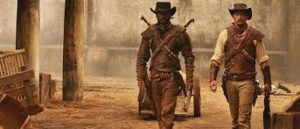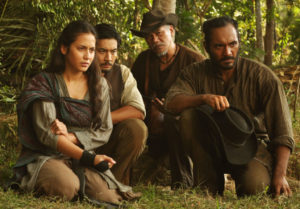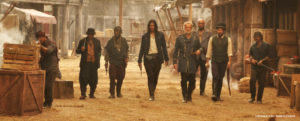martial arts
SDAFF 2018: BUFFALO BOYS: Starts with a Bison (Bye son) scenario
November 17, 2018
by Dr. Craig D. Reid
 Each year I’ve covered SDAFF, there’s always been one film that takes me by surprise, something that I didn’t see coming or wasn’t told about and thus it wasn’t on my radar. I reversed the process and put it on my radar, and that’s why radar is spelled the same way forwards and backwards. Directed by Mike Wiluan, Buffalo Boys (not related to the famous Buffalo Soldiers, a black cavalry regiment so named by Native Americans in 1868), but based on a story that the film’s beginning elucidates is a folklore legend that arose in Java due to the Dutch’s cruel and brutal treatment of Indonesians 1610-1800.
Each year I’ve covered SDAFF, there’s always been one film that takes me by surprise, something that I didn’t see coming or wasn’t told about and thus it wasn’t on my radar. I reversed the process and put it on my radar, and that’s why radar is spelled the same way forwards and backwards. Directed by Mike Wiluan, Buffalo Boys (not related to the famous Buffalo Soldiers, a black cavalry regiment so named by Native Americans in 1868), but based on a story that the film’s beginning elucidates is a folklore legend that arose in Java due to the Dutch’s cruel and brutal treatment of Indonesians 1610-1800.
What’s the surprise and what’s the folklore? The surprise is that Buffalo Boys is an Indonesian martial arts influenced film that features their national fighting art pencak silat‘s weaponry and empty hand fighting skills in 1860 California. It’s not a spaghetti or noodle Western, it’s a rowdy rustlin’ rendeng buffaloboy (compared to cowboy) Western that begins on a train rolling down a railroad track 10 years after statehood and three years before the completion of the transcontinental railroad.
 It’s a story about how two strapping, yet well trained gunmen and silat fighters, the older and reserved Jamar (Ario Bayu) and the affable, softer featured Suwo (Yoshi Sudarso), who after their Sultan father Hamsa sacrifices his life by fighting traitorous Javanese assassins working for the Dutch in 1840, bought them time to escape from to America with their uncle Arana, return to Java and exact revenge against the sadistic Dutch governor Van Trach who cold heartedly executed their dad on the beach as the babies boated away.
It’s a story about how two strapping, yet well trained gunmen and silat fighters, the older and reserved Jamar (Ario Bayu) and the affable, softer featured Suwo (Yoshi Sudarso), who after their Sultan father Hamsa sacrifices his life by fighting traitorous Javanese assassins working for the Dutch in 1840, bought them time to escape from to America with their uncle Arana, return to Java and exact revenge against the sadistic Dutch governor Van Trach who cold heartedly executed their dad on the beach as the babies boated away.
In the opening fight on a moving train’s railroad car where riders watch and bet on boxing matches, Jamar is facing a boxer twice his size purposely losing the battle that lowers his odds of winning. After being tossed around the car like a rag doll, Suwo tells him it’s time to win. Also knowing how to box, which would make sense, when he burst into silat kicks, jumping punches and two-arm solid, power-absorbing blocks, he soon makes mincemeat of the boxer and now they can afford to head home to Java.
 What little I know about Indonesian history, my guess is that Jamar and Suwo might together represent the famous Indonesian freedom fighter Temur Umar, who fought in the Battle of Aceh against Dutch colonial armies at age 19 and continued fighting until his death. He married Indonesia’s most famous female warrior Cut Nyak Dhien that fought by his side and perhaps the movie’s expert female archer Kiona (Pevita Pearce) is Cut.
What little I know about Indonesian history, my guess is that Jamar and Suwo might together represent the famous Indonesian freedom fighter Temur Umar, who fought in the Battle of Aceh against Dutch colonial armies at age 19 and continued fighting until his death. He married Indonesia’s most famous female warrior Cut Nyak Dhien that fought by his side and perhaps the movie’s expert female archer Kiona (Pevita Pearce) is Cut.
Though the first fight is lighthearted, the bout’s ending gives us a clue that jocularity will quickly fade and it does when they arrive home to a country and fearful people desolated and ravaged by their Dutch conquerors as you get eyefuls of atrocious and barbarous lessons dealt out by Javanese fighters and lackeys collaborating with the Dutch.
Thus, we’re all waiting for the obvious round two fights between the brothers and the various Javanese collaborators that get the best of them earlier in the film. It’s akin to Bruce Lee being slapped around by the Japanese at the beginning of Chinese Connection (aka Fist of Fury; 1973), where you know payback occurs in both movies with gleeful cheer and a rambunctious veneer, except Buffalo Boys uses silat, swords and knives that are beautifully intertwined with the sensibility of a Sergio Leon, Clint Eastwood starring spaghetti Western, complete with tight angles on their eyes and whistling in the music.
 Historically Indonesian silat fighters are known to have achieved numerous victories against Dutch and Japanese invaders, and practitioners attribute that in part to the art’s mystical practices, including the cultivation of tenaga dalam, something akin to Chinese qigong. Though silat has five animal styles (tiger (cats), python and cobra (snakes), monkey, dragon and blekok (a bird only indigenous to Indonesia), its origins date back to when Chinese diplomats visited Persia as early as 126 B.C. Later, Persians began practicing a martial art called varzesh-e pahlavani. By 226 Persian explorers had established trade routes to the islands that form the Malay Archipelago.
Historically Indonesian silat fighters are known to have achieved numerous victories against Dutch and Japanese invaders, and practitioners attribute that in part to the art’s mystical practices, including the cultivation of tenaga dalam, something akin to Chinese qigong. Though silat has five animal styles (tiger (cats), python and cobra (snakes), monkey, dragon and blekok (a bird only indigenous to Indonesia), its origins date back to when Chinese diplomats visited Persia as early as 126 B.C. Later, Persians began practicing a martial art called varzesh-e pahlavani. By 226 Persian explorers had established trade routes to the islands that form the Malay Archipelago.
For the next 500 years, Arab Muslims conducted business there. Silat is believed to have originated between 600-1200, when the Srivijaya kingdom was a major force in the region. The fighting art underwent refinement during the Majapahit Empire (1293-1527). However, the term pencak silat didn’t appear until 1948, when it was chosen as an umbrella term to describe all Indonesian martial arts.
 Prior to the finale Buffalo Boys confrontation, which is reminiscent of the major gunfight at the O.K. Corral, the brothers are seen arming themselves like Stallone in a Rambo film (tight angles weapons being placed around the body). From 6-shooters in gun belts, bandolier ammo belts crisscrossing their bodies (message that the wearer expects combat), sawed off shotguns and grenade launching rifles (nice try, invented by Japanese in 1941) to an assortment of bladed weapons such as knives, the machete-like golok, Indonesian style double battle axes (the handle tips feature blekok-head décor), no Java warrior would be complete without silat’s piece de resistance dagger weapon, the pistol-grip handled, wavy-bladed kris, where some blades were infused with venom during forging.
Prior to the finale Buffalo Boys confrontation, which is reminiscent of the major gunfight at the O.K. Corral, the brothers are seen arming themselves like Stallone in a Rambo film (tight angles weapons being placed around the body). From 6-shooters in gun belts, bandolier ammo belts crisscrossing their bodies (message that the wearer expects combat), sawed off shotguns and grenade launching rifles (nice try, invented by Japanese in 1941) to an assortment of bladed weapons such as knives, the machete-like golok, Indonesian style double battle axes (the handle tips feature blekok-head décor), no Java warrior would be complete without silat’s piece de resistance dagger weapon, the pistol-grip handled, wavy-bladed kris, where some blades were infused with venom during forging.
Although kris has been used for centuries all over Indonesia (and Philippines), nowhere does the blade hold such significance in spiritual rituals and contain mythical powers as described in epic poetry, than in Java. The Javanese kris has a presence, a living spirit, an essence, with some blades having good luck and are honored as sanctified heirlooms. Buffalo Boys doesn’t forget to accentuate the importance of kris to the brothers.
 Overall, the empty-hand and weapon sequences are mostly filmed with 2-5 techniques per shot where the simplicity of the action is neatly hidden by using medium, side-angle (profile) tracking shots that add movement to the sequences and the shot ends when the camera stops and the actors make a small angle change away from camera to set up a kick or some powerful strike, which is easier to sell than in a profile shot. Although repetitive, because a lot of the combat is tightly edited between action sequences going on at the same time, the fights works well in the film.
Overall, the empty-hand and weapon sequences are mostly filmed with 2-5 techniques per shot where the simplicity of the action is neatly hidden by using medium, side-angle (profile) tracking shots that add movement to the sequences and the shot ends when the camera stops and the actors make a small angle change away from camera to set up a kick or some powerful strike, which is easier to sell than in a profile shot. Although repetitive, because a lot of the combat is tightly edited between action sequences going on at the same time, the fights works well in the film.
The door is open for a part 2. Maybe SDAFF 2019? Hint, hint.

 tweet
tweet share
share